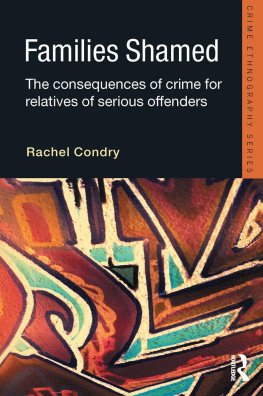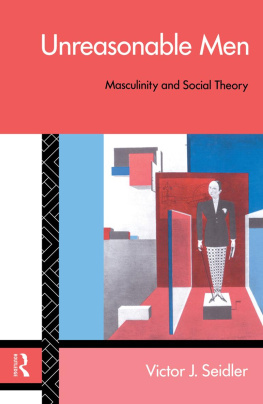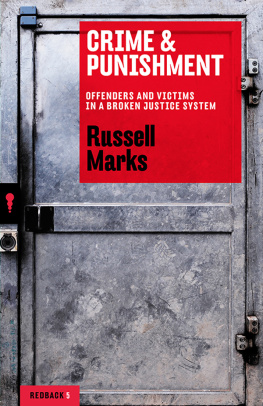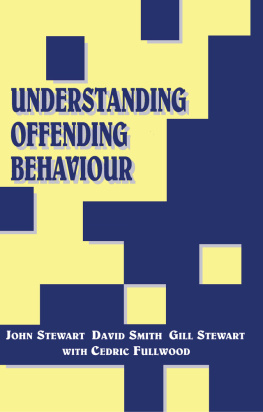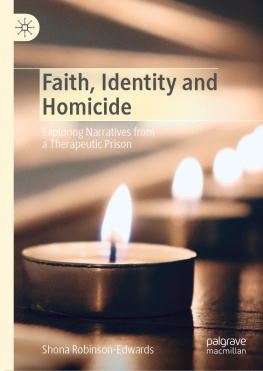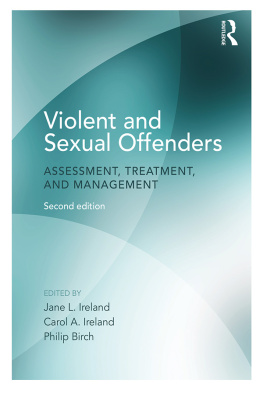CRIME
CULTURE &
VIOLENCE
Understanding How Masculinity
and Identity Shapes Offending
DR KATIE SEIDLER
First published in 2010
Australian Academic Press
32 Jeays Street
Bowen Hills Qld 4006
Australia
www.australianacademicpress.com.au
Reprinted in 2011
2010 Katie Seidler, except for Katie Seidler and Greg Noble
Copying for educational purposes
The Australian Copyright Act 1968 (Cwlth) allows a maximum of one chapter or 10% of this book, whichever is the greater, to be reproduced and/or communicated by any educational institution for its educational purposes provided that the educational institution (or the body that administers it) has given a remuneration notice to Copyright Agency Limited (CAL) under the Act. For details of the CAL licence for educational institutions contact: Copyright Agency Limited, 19/157 Liverpool Street, Sydney NSW 2000. E-mail
Production and communication for other purposes
Except as permitted under the Act, for example a fair dealing for the purposes of study, research, criticism or review, no part of this book may be reproduced, stored in a retrieval system, or transmitted in any form or by any means electronic, mechanical, photocopying, recording or otherwise without prior written permission of the copyright holder.
National Library of Australia Cataloguing-in-Publication entry
Author: | Seidler, Katie. |
Title: | Crime, culture and violence : understanding how masculinity and identity shapes offending / Katie Seidler. |
Edition: | 1st ed. |
ISBN: | 9781921513565 (pbk.) |
9781921513572 : (ebook : pdf) |
Subjects: | Crime--Social aspects--Australia. Violence--Social aspects--Australia. Violent offenders--Attitudes. |
Dewey number: | 364.994 |
Cover photograph by istockphoto.com/credhumv. Cover design by Maria Biaggini.
To Margaret,
for being an inspiration.contents
I would like to thank Dr Daphne Hewson, who was gracefully willing to take on the supervision of this research more out of faith in me rather than any knowledge or interest in crime and criminals. This research challenged her at times, but more importantly, she was able to challenge and extend me and my thinking, and this made the journey so much richer. I also want to thank Dr Greg Noble for his interest, energy, commitment and motivation, even when confronted by different disciplines and different institutions. He was always willing to help, and his continued interest and assistance has enabled this project to come to fruition.
I could not have completed this research without the assistance of the offenders I interviewed. I want to thank them for their time, commitment and honesty in assisting me by telling me their stories. I hope I have done them justice; I have endeavoured to do so.
To all the staff of the NSW Department of Corrective Services who helped facilitate this research through my visits to jails, thank you.
I also want to think Dr Chris Lennings for his assistance in reviewing the chapters for this book. His feedback and continued guidance and support have been invaluable to me.
Lastly, I need to thank the qualitative research group at Macquarie University Gayle, Alison, Tracey, Jamie, Janet and others who have come and gone. The team support you have provided me with has been invaluable, especially as qualitative research is still very new to Macquarie and the institutional support for our work is not always obvious.
I HAVE BEEN PRACTISING as a clinical and forensic psychologist for almost 15 years in New South Wales, Australia and most of my work has been with males (juvenile and adult) in custody for sex and violent crimes. I find my work fascinating and I always have. It is challenging, interesting, demanding and confronting. In particular, I enjoy the challenge of engaging offenders to consider and enact change, ultimately making them better people, thereby protecting potential victims and reducing the cost to the community. I also find it a challenge to work within the criminal justice system at a time in history when the public sentiment is generally against offering treatment to offenders. Often no one wants to hear what I have to say. Further to this, I recognise that we live in a complex society, especially here in modern multicultural Australia and I believe that this has created certain pressures on people, at least some of which may contribute to crime. Therefore, my platform has been to push greater responsibility for crime, both for offenders and for the community, so that we, as a society, may address the factors that contribute to crime and violence, thereby creating a safer society with greater opportunities for people, who will generally be happier and more fulfilled.
Living in a multicultural society has brought issues of race and culture to the fore in many Australians minds and this is reflected by the media and other social institutions. This has also implicated crime. The debate about crime and culture is a complex one and I dont think we understand the relationship between crime and culture, if any, particularly well. Some believe that being of a certain race or cultural group predisposes you to a particular type of criminal behaviour. Some are aware that particular ethic groups are overrepresented in our prison system and they wonder why this is. Some are wondering whether culture or ethnicity has become a motivation for crime. The truth is we dont really know.
Through my work, I have become particularly interested in how offenders from different cultures both commit and account for their crimes. Over the years, I have worked with many offenders whose stories about crime reflected on issues of culture, and this motivated me to embark on research exploring the relationship between culture and crime. I believe there is a need to understand these issues separate from the public frenzy around crime and ethnicity, and this understanding has many implications for various aspects of our criminal justice process, from policing to court dispositions to forensic treatment. However, the relationship between crime and culture remains unclear, and I believe it is important not to get bogged down in the public perception of any link between these concepts, and to take an inquisitive position on whether there is, in fact, a connection between cultural experience and criminal violence. Through this process we may uncover important issues surrounding crime and culture that we should not shy away from.
Several years ago, as I was thinking about these complex concepts, I was excited to receive two separate referrals to assess clients for court that highlighted for me crucial issues in relation to culture and crime. The first client was an AngloAustralian male, who was being sentenced for an assault and attempted robbery where he had tried to steal the handbag of a woman, he claimed, because he was drunk and on drugs and needed money to feed his drug habit. When she resisted him, he was both verbally and physically abusive to her, presumably because she interfered with his ability to meet his needs and achieve the desired outcome. As such, the offenders motives in offending were seemingly selfish. Further to this, although this offender came from a specific, indeed the dominant, cultural background in Australia, we would not normally think of his behaviour in ethnic terms. The other client was a young man from a Vietnamese cultural background who had fled his home country on a boat with his family to avoid the fragile political and social conditions. He had arrived here as a primary school-aged child and not long afterwards, drifted into a gang of youths from the same ethnic background. He had been involved in a situation where one of his gang identified two people as members of a rival Asian gang. He and some others attacked these men and one of the victims died as a result of stab wounds. It turned out to be a case of mistaken identity in that the victims were not known to the offenders, thus making the situation all the more tragic.


